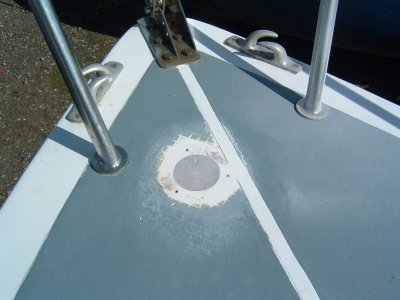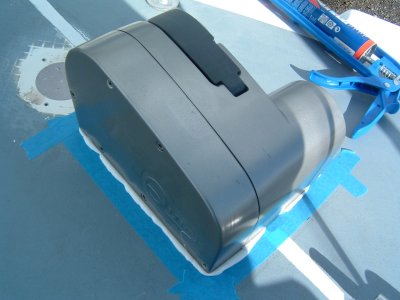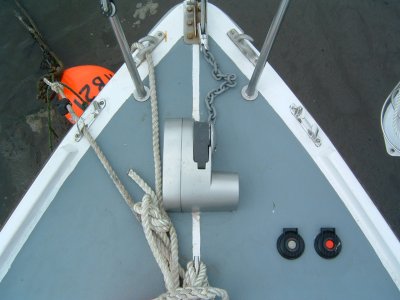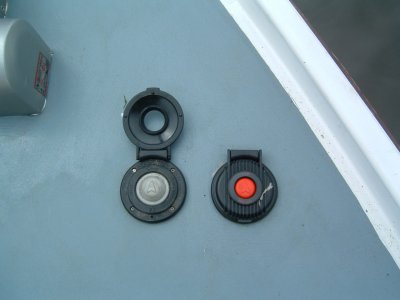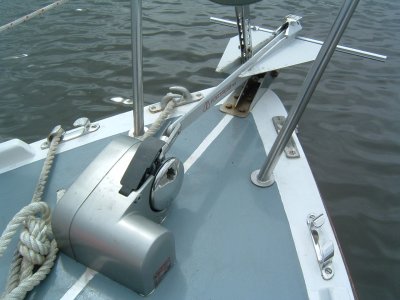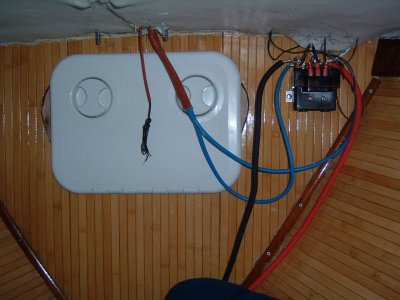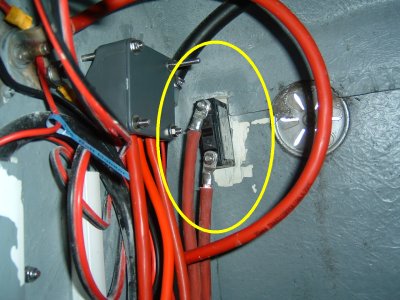Difference between revisions of "Upgrading to an Electric Windlass"
Novocastrian (talk | contribs) |
Novocastrian (talk | contribs) |
||
| Line 24: | Line 24: | ||
This particular installation uses the house battery rather than any dedicated windlass battery. Best to ensure the engine is running to avoid unnecessary drain in that battery when operating the windlass. Heavy duty cables are needed to run from the house battery all the way to the 2 way reversing contactor which should be located close to the windlass. 25mm2 flexible welding cable was ideal for the installation - it is essential that you do not use undersized cable for two reasons; the voltage drope that will be experienced and the heat that can be generated within the cable. This pic shows the 2 way reversing contactor and gives an idea of the size of cable used. | This particular installation uses the house battery rather than any dedicated windlass battery. Best to ensure the engine is running to avoid unnecessary drain in that battery when operating the windlass. Heavy duty cables are needed to run from the house battery all the way to the 2 way reversing contactor which should be located close to the windlass. 25mm2 flexible welding cable was ideal for the installation - it is essential that you do not use undersized cable for two reasons; the voltage drope that will be experienced and the heat that can be generated within the cable. This pic shows the 2 way reversing contactor and gives an idea of the size of cable used. | ||
| + | |||
| + | [[File:Windlass_Contactor.jpg]] | ||
| + | |||
| + | You also need to install a hydrualic circuit breaker. This pic shows the circuit breaker located in the engine compartment - the operating flick swicth protrudes into the cockpit area. With hindsight, it would have been better to locate the circuit breaker somewhere where the flick switch would not get kicked (and snapped) in a busy cockpit area ! | ||
| + | |||
| + | [[File:Windlass_Circuit_Breaker.jpg]] | ||
Revision as of 21:12, 1 December 2011
Many Westerly Owners, especially with the smaller models, stick with the traditional way of bringing in the anchor and chain, either by manually hauling in or maybe via a manual windlass. Westerly Yachts are all ageing these days - and so are their owners. This page explains how to install a modern electric windlass on a Centaur, but the same guidelines apply to most models.
The first step is to remove the original chainpipe and seal the hole. David's Isopon P40 is a good bridging compound as it contains a mix of resin and glassfibres for strength.
The next job is to locate the windlass (in this case a Quick Genius 600 electric windlass) and cut a square where the chain will fall through to the chain locker. Be careful when identifying where you want the windlass to be as there is a bulkhead between chain locker and forecabin and you want the chain to fall into the rearmost part of the locker but obviously not into the V berth ! A pilot hole will help verify you have chosen correctly.
The windlass is secured in place with stainless studs and you need to bed it using Sikaflex or similar seating compound.
The windlass will now be obstructing the routing of mooring warps from fairlead to cleat and on a Centaur it is difficult to avoid this. A solution is to fit new additional fairleads further from the bows which will allow warps to bypass the windlass (as in picture):
There are a variety of ways in which you can operate the windlass. Footswitches can be mounted in the deck as shown, or you could consider a remote hand-held controlling device. For this particular installation, the footswitches have proved to be practical and ideal.
This is the finished installation and as well as looking pretty neat, it saves a lot of strain on those ageing backs !
This particular installation uses the house battery rather than any dedicated windlass battery. Best to ensure the engine is running to avoid unnecessary drain in that battery when operating the windlass. Heavy duty cables are needed to run from the house battery all the way to the 2 way reversing contactor which should be located close to the windlass. 25mm2 flexible welding cable was ideal for the installation - it is essential that you do not use undersized cable for two reasons; the voltage drope that will be experienced and the heat that can be generated within the cable. This pic shows the 2 way reversing contactor and gives an idea of the size of cable used.
You also need to install a hydrualic circuit breaker. This pic shows the circuit breaker located in the engine compartment - the operating flick swicth protrudes into the cockpit area. With hindsight, it would have been better to locate the circuit breaker somewhere where the flick switch would not get kicked (and snapped) in a busy cockpit area !
